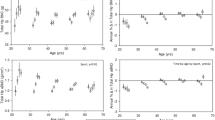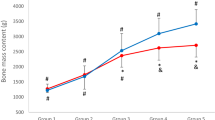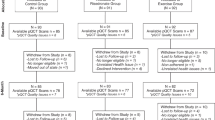Abstract
Summary
This is a study on exercise-associated bone mineral density (BMD) which in men is maintained three decades after cessation of sports. In this prospective controlled cohort study active athletes had a BMD Z-score of 1.0 and after 39 years 0.5 to 1.2 depending on the measured region), using the same single-photon absorptiometry device, dual X-ray absorptiometry (DXA), and peripheral computed tomography (pQCT).
Introduction
The aims of this study were to prospectively evaluate BMD changes in male athletes from activity into long-term retirement and to simultaneously evaluate other bone traits.
Methods
Bone mineral density (grams per square centimeter) was measured in 46 male athletes with a mean age of 22 years (range, 15–40) by using the same single-photon absorptiometry device, both at active career and a mean of 39 years (range, 38–40) later when they had long-term retired. At follow-up, BMD was also evaluated by DXA and pQCT. Twenty-four non-athletic males of similar age served as controls. Between-group differences are presented as means with 95 % confidence intervals.
Results
The active athletes (baseline) had a BMD Z-score of 1.0 (0.7, 1.4) in the femoral condyles. The retired athletes (follow-up) had a BMD Z-score of 0.5 to 1.2 depending on the measuring technique and the measured region. The tibial cortical area Z-score at follow-up was 0.8 (0.5, 1.2) and the tibial strength index Z-score 0.7 (0.4, 1.0). There were no changes in BMD Z-scores from activity to retirement, neither when estimated by the same device in different regions [∆ Z-score −0.3 (−0.8, 0.2)] nor in the same region with different devices [∆ Z-score 0.0 (−0.4, 0.4)]. The benefits remained after adjustments for anthropometrics and lifestyle. No correlation was seen with years since retirement.
Conclusions
Exercise-associated high BMD in young years seems, in men, to be maintained three decades after cessation of high-level physical activity.

Similar content being viewed by others
References
Nilsson BE, Westlin NE (1971) Bone density in athletes. Clin Orthop 77:179–182
Karlsson MK, Linden C, Karlsson C, Johnell O, Obrant K, Seeman E (2000) Exercise during growth and bone mineral density and fractures in old age. Lancet 355(9202):469–470
Lofgren B, Dencker M, Nilsson JA, Karlsson MK (2012) A 4-year exercise program in children increases bone mass without increasing fracture risk. Pediatrics 129(6):e1468–e1476
McKay HA, Petit MA, Schutz RW, Prior JC, Barr SI, Khan KM (2000) Augmented trochanteric bone mineral density after modified physical education classes: a randomized school-based exercise intervention study in prepubescent and early pubescent children [see comments]. J Pediatr 136(2):156–162
Nikander R, Sievanen H, Heinonen A, Daly RM, Uusi-Rasi K, Kannus P (2010) Targeted exercise against osteoporosis: a systematic review and meta-analysis for optimising bone strength throughout life. BMC Med 8:47
Kannus P, Haapasalo H, Sankelo M, Sievanen H, Pasanen M, Heinonen A, Oja P, Vuori I (1995) Effect of starting age of physical activity on bone mass in the dominant arm of tennis and squash players. Ann Intern Med 123(1):27–31
Hui SL, Slemenda CW, Johnston CC Jr (1990) The contribution of bone loss to postmenopausal osteoporosis. Osteoporos Int 1(1):30–34
Khan KM, Bennell KL, Hopper JL, Flicker L, Nowson CA, Sherwin AJ, Crichton KJ, Harcourt PR, Wark JD (1998) Self-reported ballet classes undertaken at age 10–12 years and hip bone mineral density in later life. Osteoporos Int 8(2):165–173
Cummings SR, Nevitt MC, Browner WS, Stone K, Fox KM, Ensrud KE, Cauley J, Black D, Vogt TM (1995) Risk factors for hip fracture in White women. Study of Osteoporotic Fractures Research Group. N Engl J Med 332(12):767–773
Bass S, Pearce G, Bradney M, Hendrich E, Delmas PD, Harding A, Seeman E (1998) Exercise before puberty may confer residual benefits in bone density in adulthood: studies in active prepubertal and retired female gymnasts. J Bone Miner Res 13(3):500–507
Kettunen JA, Impivaara O, Kujala UM, Linna M, Maki J, Raty H, Alanen E, Kaprio J, Videman T, Sarna S (2010) Hip fractures and femoral bone mineral density in male former elite athletes. Bone 46(2):330–335
Nordstrom A, Karlsson C, Nyquist F, Olsson T, Nordstrom P, Karlsson M (2005) Bone loss and fracture risk after reduced physical activity. J Bone Miner Res 20(2):202–207
Sievanen H, Kannus P (2007) Physical activity reduces the risk of fragility fracture. PLoS Med 4(6):e222
Michaelsson K, Olofsson H, Jensevik K, Larsson S, Mallmin H, Berglund L, Vessby B, Melhus H (2007) Leisure physical activity and the risk of fracture in men. PLoS Med 4(6):e199
Gustavsson A, Olsson T, Nordstrom P (2003) Rapid loss of bone mineral density of the femoral neck after cessation of ice hockey training: a 6-year longitudinal study in males. J Bone Miner Res 18(11):1964–1969
Valdimarsson O, Alborg HG, Duppe H, Nyquist F, Karlsson M (2005) Reduced training is associated with increased loss of BMD. J Bone Miner Res 20(6):906–912
Kontulainen S, Kannus P, Haapasalo H, Sievanen H, Pasanen M, Heinonen A, Oja P, Vuori I (2001) Good maintenance of exercise-induced bone gain with decreased training of female tennis and squash players: a prospective 5-year follow-up study of young and old starters and controls. J Bone Miner Res 16(2):195–201
Erlandson M, Kontulainen S, Chilibeck P, Arnold C, Faulkner R, Baxter-Jones A (2012) Higher premenarcheal bone mass in elite gymnasts is maintained into young adulthood after long-term retirement from sport: a 14-year follow-up. J Bone Miner Res. doi:10.1002/jbmr.514
Daly RM, Bass SL (2006) Lifetime sport and leisure activity participation is associated with greater bone size, quality and strength in older men. Osteoporos Int 17(8):1258–1267
Khan KM, Green RM, Saul A, Bennell KL, Crichton KJ, Hopper JL, Wark JD (1996) Retired elite female ballet dancers and nonathletic controls have similar bone mineral density at weightbearing sites. J Bone Miner Res 11(10):1566–1574
Nikander R, Kannus P, Dastidar P, Hannula M, Harrison L, Cervinka T, Narra NG, Aktour R, Arola T, Eskola H, Soimakallio S, Heinonen A, Hyttinen J, Sievanen H (2009) Targeted exercises against hip fragility. Osteoporos Int 20(8):1321–1328
Nikander R, Kannus P, Rantalainen T, Uusi-Rasi K, Heinonen A, Sievanen H (2010) Cross-sectional geometry of weight-bearing tibia in female athletes subjected to different exercise loadings. Osteoporos Int 21(10):1687–1694
Haapasalo H, Kontulainen S, Sievanen H, Kannus P, Jarvinen M, Vuori I (2000) Exercise-induced bone gain is due to enlargement in bone size without a change in volumetric bone density: a peripheral quantitative computed tomography study of the upper arms of male tennis players. Bone 27(3):351–357
Duan Y, Seeman E, Turner CH (2001) The biomechanical basis of vertebral body fragility in men and women. J Bone Miner Res 16(12):2276–2283
Seeman E, Duan Y, Fong C, Edmonds J (2001) Fracture site-specific deficits in bone size and volumetric density in men with spine or hip fractures. J Bone Miner Res 16(1):120–127
Ahlborg HG, Johnell O, Turner CH, Rannevik G, Karlsson MK (2003) Bone loss and bone size after menopause. N Engl J Med 349(4):327–334
Warden SJ, Fuchs RK, Castillo AB, Nelson IR, Turner CH (2007) Exercise when young provides lifelong benefits to bone structure and strength. J Bone Miner Res 22(2):251–259
Bass SL, Saxon L, Daly RM, Turner CH, Robling AG, Seeman E, Stuckey S (2002) The effect of mechanical loading on the size and shape of bone in pre-, peri-, and postpubertal girls: a study in tennis players. J Bone Miner Res 17(12):2274–2280
Nauclér L, Nilsson BE, Westlin NE (1974) An apparatus for gamma absorptiometry of bone—technical data. Opusc Med Tech Lund 12:19–32
Ferretti JL, Capozza RF, Zanchetta JR (1996) Mechanical validation of a tomographic (pQCT) index for noninvasive estimation of rat femur bending strength. Bone 18(2):97–102
Tveit M, Rosengren BE, Nilsson JA, Karlsson MK (2012) Former male elite athletes have a higher prevalence of osteoarthritis and arthroplasty in the hip and knee than expected. Am J Sports Med 40(3):527–533
Seeman E (2003) Reduced bone formation and increased bone resorption: rational targets for the treatment of osteoporosis. Osteoporos Int 14(Suppl 3):S2–S8
Mikkola TM, Sipila S, Rantanen T, Sievanen H, Suominen H, Kaprio J, Koskenvuo M, Kauppinen M, Heinonen A (2008) Genetic and environmental influence on structural strength of weight-bearing and non-weight-bearing bone: a twin study. J Bone Miner Res 23(4):492–498
Kristinsson JO, Valdimarsson O, Steingrimsdottir L, Sigurdsson G (1994) Relation between calcium intake, grip strength and bone mineral density in the forearms of girls aged 13 and 15. J Intern Med 236(4):385–390
Jones HH, Priest JD, Hayes WC, Tichenor CC, Nagel DA (1977) Humeral hypertrophy in response to exercise. J Bone Joint Surg Am 59(2):204–208
Bellew JW, Gehrig L (2006) A comparison of bone mineral density in adolescent female swimmers, soccer players, and weight lifters. Pediatr Phys Ther 18(1):19–22
Ferry B, Duclos M, Burt L, Therre P, Le Gall F, Jaffre C, Courteix D (2011) Bone geometry and strength adaptations to physical constraints inherent in different sports: comparison between elite female soccer players and swimmers. J Bone Miner Metab 29(3):342–351
Specker B, Binkley T (2003) Randomized trial of physical activity and calcium supplementation on bone mineral content in 3- to 5-year-old children. J Bone Miner Res 18(5):885–892
Acknowledgments
Financial support was obtained from the Swedish Medical Research Council, the Centre for Sports Medical Research (CIF), the Swedish Society of Medicine, and the Swedish Society of Medical Research.
Conflicts of interest
None.
Author information
Authors and Affiliations
Corresponding author
Rights and permissions
About this article
Cite this article
Tveit, M., Rosengren, B.E., Nilsson, JÅ. et al. Bone mass following physical activity in young years: a mean 39-year prospective controlled study in men. Osteoporos Int 24, 1389–1397 (2013). https://doi.org/10.1007/s00198-012-2081-z
Received:
Accepted:
Published:
Issue Date:
DOI: https://doi.org/10.1007/s00198-012-2081-z




